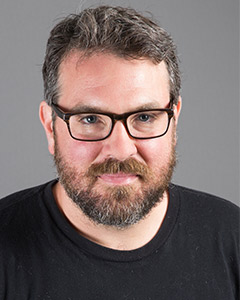Thomas Mast

Neuroscience Program Administrator, Associate Professor
Biology; Neuroscience
403D Science Complex
Education
- Postdoctoral Researcher, University of Michigan, Psychology, 2014
- Postdoctoral Researcher, Florida State University, Psychology, 2013
- Ph.D., Florida State University, Neuroscience, 2011
- MS, University of Cincinnati, Biology, 2004
- BS, Eastern Michigan University, Biology, 2001
Interests and Expertise
How do animals use chemosensation (i.e. smell and taste) to navigate their environment?
The sense of smell is crucial for foraging and mating. Not many animals, particularly small children, willingly eat food that 'smells bad'; something similar can be said of mating. I investigate how the olfactory system—a set of neural structures that detects, analyzes, and perceives smells—guides animal decision making. To this end, I use electrophysiological, histological and behavioral methods to uncover cellular and neuronal mechanisms that control olfactory function. I am particularly interested in discovering olfactory circuits for specific behaviors and cellular functions that allow the olfactory system to deal with environmental stress. Lastly, I welcome students who want to learn how to conduct science to come to the lab. Interested students will learn techniques, experimental design and (hopefully) how to think critically.
Courses
- BIO 330 Neuroanatomy
- NSCI 301 Introduction to Neuroscience
- NSCI 401 Advanced Neuroscience
- BIO 447/547 Scanning Electron Microscopy
Publications and Presentations
- *Townsley CR, Breza JM, Mast TG. Movement assay for the undergraduate neuroscience laboratory. HardwareX. 2020 7:e00094. doi.org/10.1016/j.ohx.2020.e00094.
- Mast TG, *Zuk K, *Rinke A, *Quasem K, *Savard B, *Brobbey C, *Reiss J, *Dryden M. Temporary anosmia in mice following nasal lavage with dilute detergent solution. Chem Senses. 2019 44:639-648. doi: 10.1093/chemse/bjz047.
- *Raymond MA, Mast TG, Breza JM. An open-source lickometer and microstructure analysis program. HardwareX. 2018 4:e00035. doi:10.1016/j.ohx.2018.e00035
- *Whiddon ZD, *Rynberg ST, Mast TG, Breza JM. Aging decreases chorda-tympani nerve responses to NaCl and alters morphology of fungiform taste pores in rats. Chem Senses. 2018 43:117‐128. doi:10.1093/chemse/bjx076
- Seidel HS, *Smith TA, Evans JK, *Stamper JQ, Mast TG, Kimble J. C. elegans germ cells divide and differentiate in a folded tissue. Dev Biol. 2018 442:173‐187. doi:10.1016/j.ydbio.2018.07.013
- Mast TG, Fadool DA. 2012. Mature and precursor brain-derived neurotrophic factor have individual roles in the mouse olfactory bulb. PLOS One 7(2) e:31978. PMID: 22363780
- Marks DR, Tucker K, Cavallin MA, Mast TG, Fadool DA. 2009. Awake intranasal insulin delivery modifies protein complexes and alters memory, anxiety, and olfactory behaviors. J. Neurosci. 29: 6734–6751. PMID: 19458242
- Biju KC, Mast TG, and Fadool DA. 2008. Olfactory sensory-deprivation increases the number of proBDNF immunoreactive mitral cells in the olfactory bulb of mice. Neurosci. Lett. 447: 42–7. PMID: 18834927
- Mast TG, ER Griff. 2007. The effects of analgesic supplements on neural activity in the main olfactory bulb of the mouse. Comp. Med. 57: 167–174. PMID: 17536617
* EMU student
